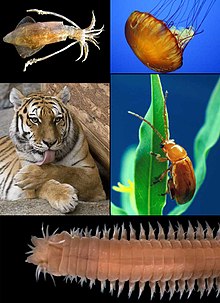
Back ParaHoxozoa Afrikaans نظائر حيوانات النحت Arabic ParaHoxozoa Spanish پیراهوکسوزوآ Persian Parahoxozoa Hungarian ParaHoxozoa ID ParaHoxozoa Malay ParaHoxozoa Portuguese ParaHoxozoa SIMPLE ParaHoxozoa Serbian
| ParaHoxozoa | |
|---|---|

| |
| Diversity of parahoxozoans | |
| Scientific classification | |
| Domain: | Eukaryota |
| Kingdom: | Animalia |
| Subkingdom: | Eumetazoa |
| Clade: | ParaHoxozoa Ryan et al., 2010 |
| Taxa | |
ParaHoxozoa (or Parahoxozoa) is a clade of animals that consists of Bilateria, Placozoa, and Cnidaria.[1] The relationship of this clade relative to the two other animal lineages Ctenophora and Porifera is debated. Some phylogenomic studies have presented evidence supporting Ctenophora as the sister to Parahoxozoa and Porifera as the sister group to the rest of animals (e.g. [2][3][4]). Other studies have presented evidence supporting Porifera as the sister to Parahoxozoa and Ctenophora as the sister group to the rest of animals (e.g. [5][6][7]), finding that nervous systems either evolved independently in ctenophores and parahoxozoans,[8] or were secondarily lost in poriferans.[9] If ctenophores are taken to have diverged first, Eumetazoa is sometimes used as a synonym for ParaHoxozoa.[10]
- ^ Ryan, Joseph F.; Pang, Kevin; Mullikin, James C.; Martindale, Mark Q.; Baxevanis, Andreas D. (2010-10-04). "The homeodomain complement of the ctenophore Mnemiopsis leidyi suggests that Ctenophora and Porifera diverged prior to the Parahoxozoa". EvoDevo. 1 (1): 9. doi:10.1186/2041-9139-1-9. ISSN 2041-9139. PMC 2959044. PMID 20920347.
- ^ Pick, K. S.; Philippe, H.; Schreiber, F.; Erpenbeck, D.; Jackson, D. J.; Wrede, P.; Wiens, M.; Alie, A.; Morgenstern, B.; Manuel, M.; Worheide, G. (2010). "Improved Phylogenomic Taxon Sampling Noticeably Affects Nonbilaterian Relationships". Molecular Biology and Evolution. 27 (9): 1983–1987. doi:10.1093/molbev/msq089. ISSN 0737-4038. PMC 2922619. PMID 20378579.
- ^ Feuda, Roberto; Dohrmann, Martin; Pett, Walker; Philippe, Hervé; Rota-Stabelli, Omar; Lartillot, Nicolas; Wörheide, Gert; Pisani, Davide (2017). "Improved Modeling of Compositional Heterogeneity Supports Sponges as Sister to All Other Animals". Current Biology. 6 (24): 3864–3870.e4. Bibcode:2017CBio...27E3864F. doi:10.1016/j.cub.2017.11.008. hdl:11572/302898. PMID 29199080.
- ^ Simion, Paul; Philippe, Hervé; Baurain, Denis; Jager, Muriel; Richter, Daniel J.; Franco, Arnaud Di; Roure, Béatrice; Satoh, Nori; Quéinnec, Éric (3 April 2017). "A Large and Consistent Phylogenomic Dataset Supports Sponges as the Sister Group to All Other Animals" (PDF). Current Biology (Submitted manuscript). 27 (7): 958–967. Bibcode:2017CBio...27..958S. doi:10.1016/j.cub.2017.02.031. ISSN 0960-9822. PMID 28318975. S2CID 4560353.
- ^ Whelan, Nathan V.; Kocot, Kevin M.; Moroz, Leonid L.; Halanych, Kenneth M. (2015). "Error, signal, and the placement of Ctenophora sister to all other animals". Proceedings of the National Academy of Sciences. 112 (18): 5773–5778. Bibcode:2015PNAS..112.5773W. doi:10.1073/pnas.1503453112. ISSN 0027-8424. PMC 4426464. PMID 25902535.
- ^ Borowiec, Marek L.; Lee, Ernest K.; Chiu, Joanna C.; Plachetzki, David C. (2015). "Extracting phylogenetic signal and accounting for bias in whole-genome data sets supports the Ctenophora as sister to remaining Metazoa". BMC Genomics. 16 (1): 987. doi:10.1186/s12864-015-2146-4. ISSN 1471-2164. PMC 4657218. PMID 26596625.
- ^ Whelan, Nathan V.; Kocot, Kevin M.; Moroz, Tatiana P.; Mukherjee, Krishanu; Williams, Peter; Paulay, Gustav; Moroz, Leonid L.; Halanych, Kenneth M. (2017). "Ctenophore relationships and their placement as the sister group to all other animals". Nature Ecology & Evolution. 1 (11): 1737–1746. Bibcode:2017NatEE...1.1737W. doi:10.1038/s41559-017-0331-3. ISSN 2397-334X. PMC 5664179. PMID 28993654.
- ^ Moroz, Leonid L.; Kocot, Kevin M.; Citarella, Mathew R.; Dosung, Sohn; Norekian, Tigran P.; Povolotskaya, Inna S.; Grigorenko, Anastasia P.; Dailey, Christopher; Berezikov, Eugene; Buckley, Katherine M.; Ptitsyn, Andrey; Reshetov, Denis; Mukherjee, Krishanu; Moroz, Tatiana P.; Bobkova, Yelena; Yu, Fahong; Kapitonov, Vladimir V.; Jurka, Jerzy; Bobkov, Yuri V.; Swore, Joshua J.; Girardo, David O.; Fodor, Alexander; Gusev, Fedor; Sanford, Rachel; Bruders, Rebecca; Kittler, Ellen; Mills, Claudia E.; Rast, Jonathan P.; Derelle, Romain; Solovyev, Victor V.; Kondrashov, Fyodor A.; Swalla, Billie J.; Sweedler, Jonathan V.; Rogaev, Evgeny I.; Halanych, Kenneth M.; Kohn, Andrea B. (2014). "The ctenophore genome and the evolutionary origins of neural systems". Nature. 510 (7503): 109–114. Bibcode:2014Natur.510..109M. doi:10.1038/nature13400. ISSN 0028-0836. PMC 4337882. PMID 24847885.
- ^ Ryan, J. F.; Pang, K.; Schnitzler, C. E.; Nguyen, A.-D.; Moreland, R. T.; Simmons, D. K.; Koch, B. J.; Francis, W. R.; Havlak, P.; Smith, S. A.; Putnam, N. H.; Haddock, S. H. D.; Dunn, C. W.; Wolfsberg, T. G.; Mullikin, J. C.; Martindale, M. Q.; Baxevanis, A. D. (2013). "The Genome of the Ctenophore Mnemiopsis leidyi and Its Implications for Cell Type Evolution". Science. 342 (6164): 1242592. doi:10.1126/science.1242592. ISSN 0036-8075. PMC 3920664. PMID 24337300.
- ^ Erives, Albert; Fritzsch, Bernd (2020). "A Screen for Gene Paralogies Delineating Evolutionary Branching Order of Early Metazoa". G3: Genes, Genomes, Genetics. 10 (2): 811–826. doi:10.1534/g3.119.400951. ISSN 2160-1836. PMC 7003098. PMID 31879283.
© MMXXIII Rich X Search. We shall prevail. All rights reserved. Rich X Search